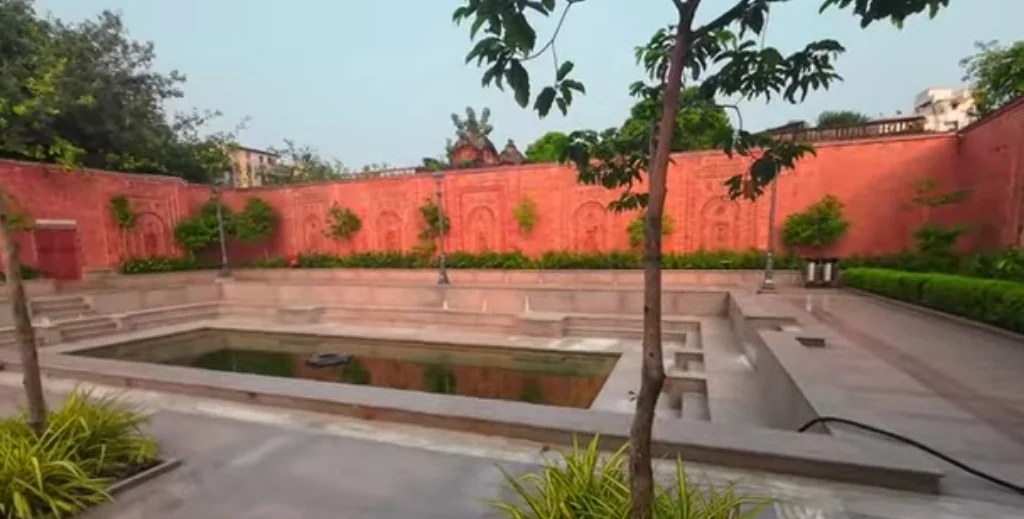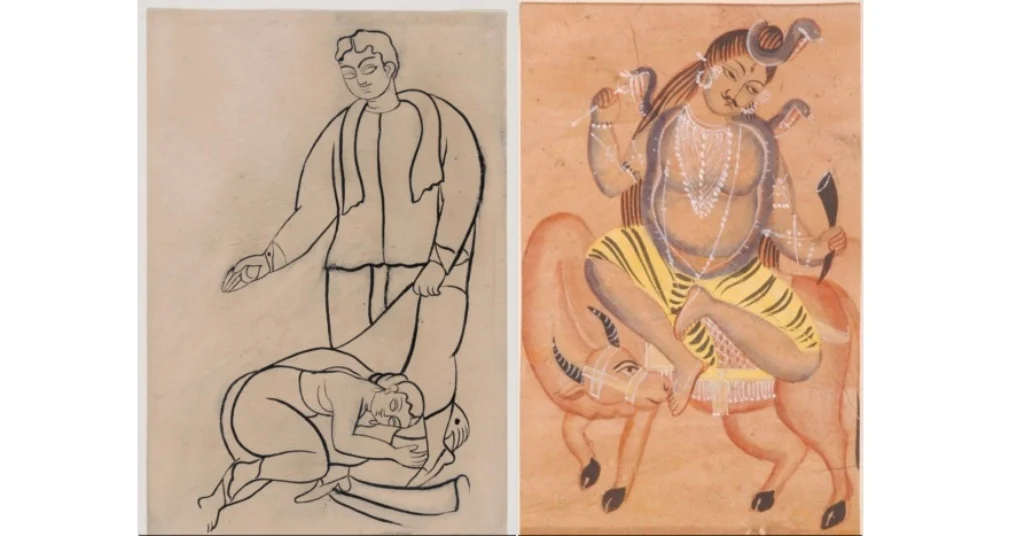Kalighat Kali Temple is not just a temple; it’s an emotion, an energy field, a living legacy of the Goddess herself.
Kalighat is one of the 51 sacred Shakti Peethas in India. It’s not just a holy place – it’s a beautiful blend of mythology, faith and cultural history. When you enter the busy area of Kalighat in Kolkata, the atmosphere changes. It feels alive with the scent of incense, devotion, and spiritual energy.
Whether you’re a pilgrim, a traveler, or a spiritual seeker, understanding Kalighat is like uncovering Kolkata’s soul.
The Myth Behind Kalighat Kali Temple
According to the Hindu Puranas, Sati, the daughter of Prajapati Daksha, married Shiva against her father’s wishes. Daksha performed a grand yajna (sacrifice) but did not invite Sati or Shiva. Even so, Sati went to the yajna, where Daksha ignored her and insulted Shiva. Unable to bear the insult, Sati offered herself into the fire. Filled with grief, Shiva wandered the universe carrying her half-burnt body. At last, Vishnu used his Sudarshan Chakra to cut her body into 51 parts, which fell on different places across the earth. Each of these places became a Shakti Peeth.
The Kalighat Kali Temple is believed to mark the spot where Sati’s right toe fell, making it one of the most admired Shakti Peethas. It is one of the four Adi Shaktipeethas alongside Vimala, Tara Tarini and Kamakhya. Being one of the four Adi Shakti Peethas the temple draws hundred of thousands of devotees throughout the year, especially on occasions like Kali Puja, Poila Baisakh (Bengali New Year), Durga Puja and Amavasyas.
Historical Records
While the exact origin date of the temple is not clear, references to Kalighat appear in 16th-century texts and Mangal-Kavyas (Bengali religious poetry). Pilgrims used to visit a small hut-like shrine at the site of the toe’s descent. The place was once a forested riverside zone near the Adi Ganga (a branch of the Hooghly).
The Kalighat Kali temple in its present form is about 200 years old. It was constructed in 1809 by the Sabarna Roy Chowdhury family of Bengal. Santosh Roy Chowdhury, a Kali devotee himself, started the construction of the present-day temple in 1798. It took 11 years to complete the construction. In 1835 Kashinath Roy built a Nat Mandir in the temple square. Although the site had been a spiritual destination long before that. Earlier, a small temple existed, believed to have been built in the 16th century by a devotee named Brahmananda Giri.
In 2024, the 200-year old temple received its first major modern era renovation since its establishment in 1809. Undertaken at a budget of Rs.200 crore, Rs.165 crore was provided by the Kolkata Municipal Corporation, while Mukesh Ambani contributed Rs.35 crore from the Reliance Foundation as a sign of devotion towards Maa Kali.
Architecture & Symbolism
Goddess Kali’s Unique Form
Unlike the fierce depictions of Kali elsewhere, the idol at Kalighat is distinct:
- The deity has three large eyes– symbolizing past, present, and future.
- The tongue is made of gold and protrudes – signifying both bloodlust and remorse.
- She stands upon a silver idol of Lord Shiva, signifying cosmic balance.
The idol is not sculpted from ordinary stone. Skilled artisans crafted it from touchstone (Kashti Pathar), which makes it both unique and deeply spiritual.
Blend of Devotion and Simplicity
The temple is constructed according to the ath-chala style of Bengal temple architecture. It blends Bengal’s traditional “nabaratna” (nine spires) style with a humble courtyard, multiple shrines, and sacred tanks like the Kundupukur – used for ritualistic bathing and puja offerings.

The main temple is a four-sided building that features a shortened dome. The two roofs bear a total of eight faces. Both of them are painted in metallic silver colour while the borders at the pillar are painted with yellow, red, green and blue.
The absolute top has three pinnacles, the tallest of which has a triangular pennant flag. The outer walls of the temple are designed with diamond-shaped chessboard pattern styles of alternating green and white. The borders below the ath-chala are elaborately designed with terracotta motifs of various Hindu deities and natural elements, which is a significant element in most of the historical temples in Bengal architecture.
Geographical Location of Kalighat Temple:
Kalighat Kali Temple is located in the southern part of Kolkata, the capital city of West Bengal, India. It stands on the banks of the Adi Ganga, a small stream that once connected to the Hooghly River and served as an ancient channel of the Ganges.
How to Reach Kalighat Kali Temple, Kolkata:
- By Air: Netaji Subhash Chandra Bose International Airport at Kolkata is the nearest airport to Kalighat. Kalighat is easily accessible from this airport by road.
- By Train: Nearest railheads are Howrah and Sealdah. Buses are available from there for Kalighat.
- By Metro: The nearest metro station is Kalighat.
- By Road: Kalighat is in south Kolkata. You can reach the temple by bus from any part of the city. Get down at the Kalighat (Kalighat Tram Depot) bus stop and walk along Kali Temple Road to the temple. You can also reach the temple easily by cab.
Kalighat Kali Temple: Daily Life & Rituals
Intense Devotion in Every Corner
The priests start the day early with Mangalarati. They wake the goddess by chanting and lighting incense. All day long, the temple stays busy with:
- Offerings of hibiscus flowers, which are considered dear to Kali.
- Animal sacrifices, still performed occasionally as per traditional Shakta customs.
- Chanting of “Jai Maa Kali” echoing through the walls.
In the afternoon, priests perform the Bhog Aarti, and in the evening, they hold the Sandhya Aarti. These are powerful moments when you can feel the emotions of hundreds of devotees as they offer their prayers, hopes, and even tears.
Kalighat vs. Dakshineswar: Two Faces of Divine Feminine Worship
| Feature | Kalighat Kali Temple | Dakshineswar Kali Temple |
| Location | South Kolkata | North Kolkata (on the banks of the Hooghly) |
| Deity | Kali as Dakshina Kali | Bhavatarini form of Kali |
| Atmosphere | Intense, raw spiritual energy | Serene, organized, spacious |
| Architecture | Traditional Bengal style | Navaratna with temple complex |
| Devotee Profile | Locals, tantriks, deep-rooted followers | Tourists, casual devotees, and pilgrims |
| Historical Significance | One of 51 Shakti Peethas | Built by Rani Rashmoni, frequented by Ramakrishna |
Both temples give powerful but different experiences. Kalighat shows raw energy, while Dakshineswar offers calm and peaceful reflection.
Unique Cultural Footprints of Kalighat Kali Temple
Kalighat Paintings: Art as Devotion
The Kalighat Patachitra style of painting evolved in the 19th century around the temple. These scrolls, initially used by rural storytellers (patuas), later transformed into vibrant paintings that reflect:

- Hindu mythology
- Social satire
- Colonial critiques
Explore Kalighat Paintings at Victoria Memorial Hall.
Tantric Practices and Spiritual Power Spots
Kalighat has strong links to Tantric traditions and attracts yogis and seekers of hidden wisdom. Some parts of the temple are known as power spots or “Siddhi Sthals,” where people believe meditation and spiritual practice bring stronger results.
Navigating the Kalighat Kali Temple: Tips for Visitors
Best Time to Visit
- Avoid Tuesdays and Saturdays if you dislike crowds-these are most auspicious for Kali worship.
- Early mornings (6–7 AM) offer a more peaceful darshan.
Things to remember
- Beware of unsolicited “guides” or pandas who may demand high fees.
- Footwear is not allowed-wear socks if visiting in summer.
- Photography is strictly prohibited inside the sanctum.
Nearby Attractions
Near Kalighat Kali Temple, you can visit the Victoria Memorial and St. Paul’s Cathedral. For cultural spots, head to the Birla Planetarium or Alipore Zoo. If you love nature, Rabindra Sarobar Lake is a great choice. You can also explore the Indian Museum or go shopping at New Market.
Why Kalighat Kali Temple Still Matters Today
In a world full of mindfulness apps and quick-fix spirituality, Kalighat gives you something raw and real. It doesn’t comfort-it stirs you. It pushes you to face the dark, destructive parts of life and accept them as part of the divine truth.
Kalighat is not a tourist spot. It’s a mirror, a mother, and a mystery-all rolled into one.
May your visit to Kalighat Kali Temple ignite your spirit with courage, devotion, and divine clarity.
FAQs:
In the Kalighat temple, it’s believed that the toes of the right foot of Goddess Sati fell.
Kalighat Kali Temple is open daily from 5:00 AM to 2:00 PM and again from 5:00 PM to 10:30 PM.
No, there is no entry fee for visitors to Kalighat Kali Temple. However, if you wish to perform any special pujas or rituals, there are some associated charges.
There isn’t an official VIP Darshan option. It is an illegal activity conducted by unauthorized priests outside the temple, where they ask for ₹200 to enter and another ₹500 to bypass the queue, with no official receipt given.
Snan Yatra is a ceremonial bathing of the Kali idol, where priests offer it a ritual bath-often blindfolded-as part of purification rituals.
Photography is strictly prohibited inside the main temple premises. Devotees and tourists are advised to respect the sanctity of the temple and refrain from taking any photographs
Yes, foreign tourists are welcome to visit Kalighat Kali Temple. They should follow the same codes of conduct as other visitors, such as dressing modestly and removing shoes before entering the temple premises.




Pingback: Naina Devi Temple: Myth, Majesty & Must-Know Travel Guide - Temples of India
Pingback: Chamunda Devi Temple: A Sacred Journey Beyond Fear and Faith - Temples of India